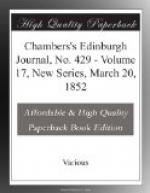The affluent Hindoo Baboo or Mohammedan Nawab, among other luxuries, keeps also his aviary. In these may be seen rare and expensive parrots, brought from the Spice Islands. They delight also in diyuls and shamahs. The latter is a smaller bird than our thrush, but larger than a lark; his breast is orange, the rest of his plumage black, and in song he is equal to our black-bird. The diyul also sings sweetly; he is about the same size as the shamah, his plumage black, with a white breast, and white tips to his wings. A well-trained bird of either kind sells for about ten rupees, and twenty will be given for a cuckoo from the Nepaul hills. A Baboo whom I knew had several servants to look after his aviary, one of whom had to go daily in search of white ants and ants’ eggs for his insectivorous charge; for the shamah and diyul are both insect-eaters.
Some of the Minas (Gracula), of which there are several kinds in India, articulate as distinctly, and are as imitative, as the parrots. One of these birds was once brought as a present to my little girl. The donor took his leave, assuring us that the bird was a great speaker, and imitated a variety of sounds. This I found to be too true, for I was awakened by him next morning at dawn of day. He had evidently been bred in the neighbourhood of the hospital, and also initiated into the mysteries of the parade. He coughed like a consumptive patient, groaned like one in agony, and moaned as if in the last extremity. Then he would call a ‘halt!’ and imitate the jingling of the ramrods in the muskets so exactly, that I marvelled how his little throat could go through so many modulations. I was soon obliged to banish him to a distance from the sleeping-apartments, for some of his utterances were anything but suggestive of soothing or pleasurable sensations.
The hill mina, a mountaineer by birth, seldom lives long in confinement in lowland districts. After having endeared himself to his master and his family by his conversational powers and imitative qualities, he is not unfrequently cut off suddenly by a fit, and sometimes expires while feasting on his bread and milk or pea-meal-paste, or perhaps when he has only a few minutes before been calling out loudly his master’s name or those of the children. The hill mina is a handsome bird, a size larger than our black-bird; he is of one uniform colour—a glossy black, like the smoothest Genoa velvet, harmonising beautifully with the bright yellow circle of skin round his eyes, his yellow beak and yellow legs.
The grackle or salik, which is a great favourite in the Isle of France, has been correctly enough described in Partington’s Cyclopaedia. It is a gregarious bird, greatly enlivening the aspect of the grassy meadows at sunset, when his comrades assemble in large flocks, and having picked up their last meal of grubs and grasshoppers, resort for shelter to a neighbouring avenue, where they roost for the




